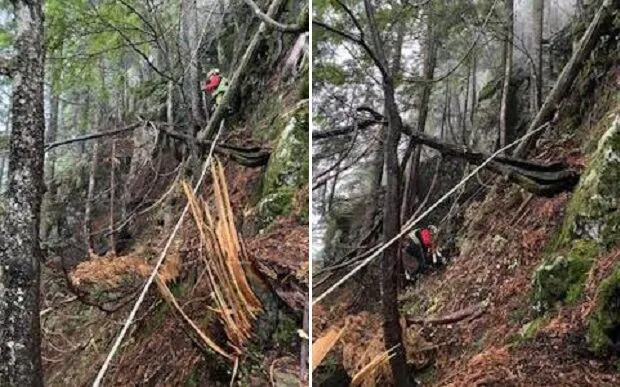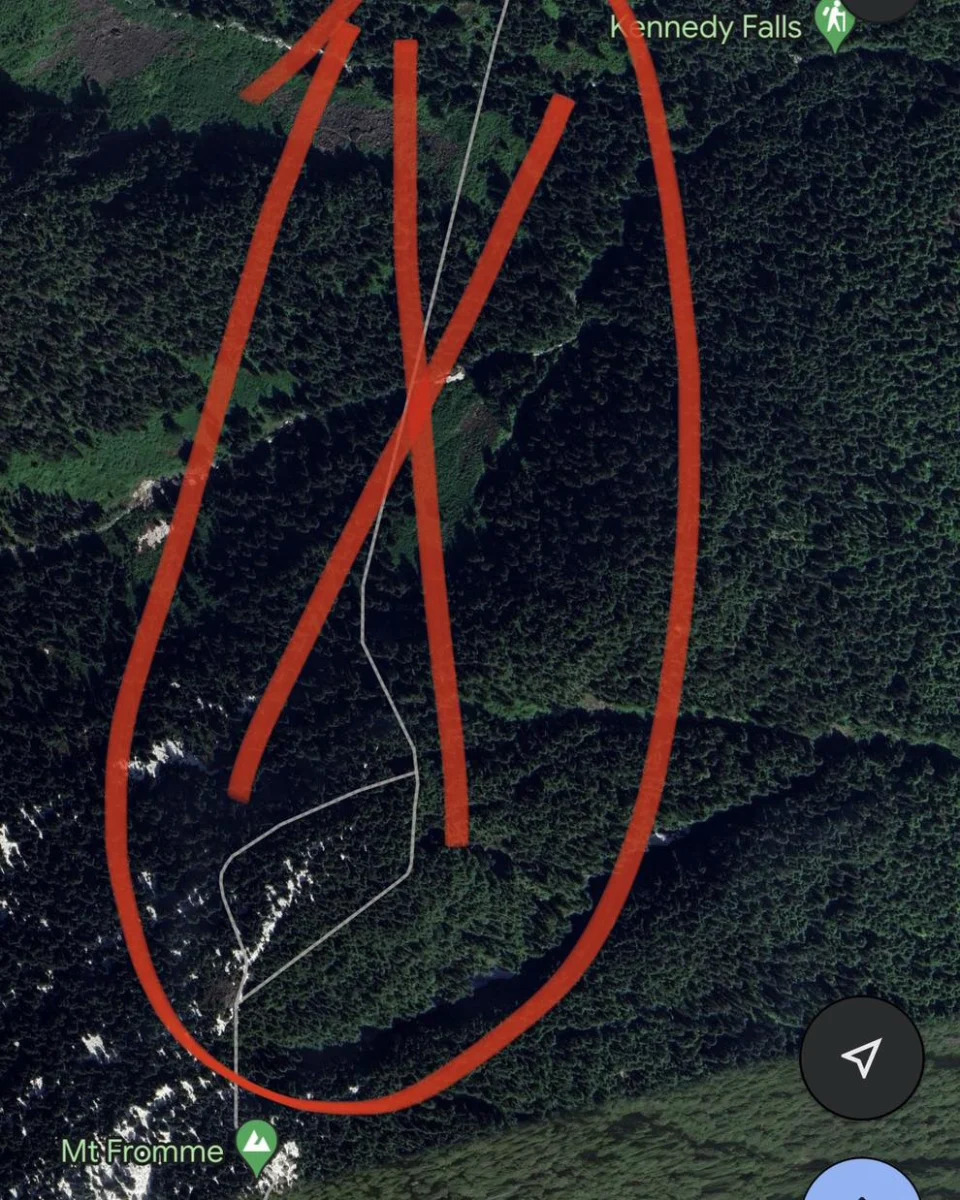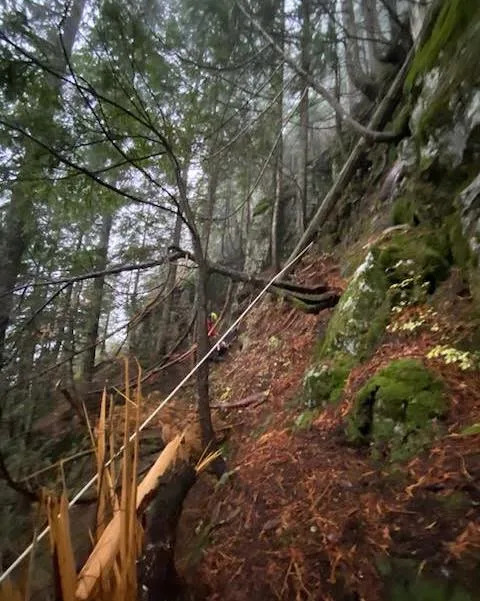Missing Colorado hiker's dog found alive, waiting by owner's body after months in wilderness
AMARIS ENCINAS, USA TODAY
November 13, 2023

Authorities conduced an aerial search in order to find Rich Moore, 71, and Jack Russell Terrier Finney, who were spotted by a hunter on Oct. 30. They had been missing for nearly three months.
A Colorado hiker who was missing for months was found dead in late October, but his 14-year-old Jack Russell terrier was found alive and waiting by the hiker's side, according to reports from the area.
A hunter came across the body of 71-year-old Rich Moore in the Lower Blanco drainage basin on Oct. 30, according to reporting by 9News in Colorado. And Moore's white Jack Russell terrier, Finney, was found alive nearby.
A flight crew headed out later that afternoon to find a suitable landing zone to recover the body but were unable to recover Moore and his dog until the next day.
After locating the pair, they were flown off the mountain by a search and rescue team.
Finney was reunited with her family after examination and treatment at a local animal hospital, according to the affiliate.
Delinda Vanne-Brightyn of Taos Search and Rescue, an agency that helped participate in the search for Moore noted how difficult it was to get to their location.
"We searched from just under the peak-top and directly West, searching down the mountain toward where his car was located. Winds were directly from the West/Soutwest. It was so steep, we were inserted in by a helicopter. He was found 2.5 miles East of the mountain-top beneath where we were inserted," according to the agency's Facebook page.
Taos Search and Rescue also extended their condolences to the family but were glad the family was able to gain some closure as well as bring their dog back home.
When were Rich Moore and his pup first reported missing?
The duo was first reported missing on the evening of Aug. 19 in the Blackhead Peak area, a rugged mountain peak east of Pagosa Springs, a Colorado town 35 miles north of the New Mexico border. They had failed to return from a hike up 12,500-foot mountain's peak, DogTime reported.
Authorities conducted an extensive search of the area, spending almost 2,000 hours looking for Moore and his pup.
Moore’s cause of death is currently unknown, but the Archuleta County Sheriff’s Office does not suspect a crime has been committed.
More: Going for a day hike? How to prepare, what to bring
CHRIS BOYETTE, CNN
November 14, 2023

From Chaffee County Search and Rescue North
A hiker who was unprepared for conditions at over 13,000 feet up in the Colorado Rockies was rescued when searchers followed footprints in freshly fallen snow to find them “alive but very hypothermic,” rescuers said.
“When inclement weather moved in the hiker found themself unprepared; out of water, with no food, wearing only a cotton hoodie and no way to warm themselves,” Chaffee County Search and Rescue North said in a news release.
“With darkness approaching and hypothermia setting in the individual decided, rather than take the same way down the best plan was to bail down an avalanche chute to try to get to a road.”
An avalanche chute is a natural path down a slope created by frequent avalanches.
About 25 search and rescue team members deployed to search for the hiker as a severe snowstorm blew in, according to the news release.
Around 12:42 a.m. Thursday, a team member spotted footprints in 6 to 8 inches of freshly fallen snow, and began to follow them, according to the news release.
“This team continued to follow the footprints until they came upon an unusual looking rock” at approximately 2 a.m., the release said. “Upon further investigation it was determined it was not a rock but the subject sitting upright in a fetal position covered in snow.”
The hiker was “alive but very hypothermic,” and rescuers spent three hours warming them up before starting the process of getting them down the gully, the search and rescue team said.
Initially, ropes were used to lower the hiker one section at a time until they said they thought they could walk and made their own way down the remaining stretch of the slope to an ambulance waiting to check them out, the rescue team said.
Chaffee County is in central Colorado on the eastern slope of the Rocky Mountains near the Continental Divide.
Non-existent trail removed from Google Maps after another rescue in Vancouver's North Shore mountains
CBC
Mon, November 13, 2023

North Shore Rescue posted photos of a rescue volunteer on the steep north side of Mount Fromme who helped save a hiker who followed a non-existent trail marked on Google Maps. (North Shore Rescue - image credit)
A search-and-rescue organization says it has finally been successful in getting Google to remove a non-existent trail from its Maps app, after crew members were again called to pull a stranded hiker out of dangerous terrain in the North Shore mountains near Vancouver.
Both helicopter and rope teams with North Shore Rescue (NSR) were needed to save the male hiker who became stranded on the non-existent trail on the north side of Mount Fromme on Nov. 4.
NSR said it made a similar helicopter rescue in the same area on Sept. 20.
Google Maps displayed the non-existent trail as heading north from the summit of Mount Fromme — which is located just east of the popular ski hill of Grouse Mountain — toward the vicinity of Kennedy Falls, in what NSR describes as "extremely steep and dangerous terrain."
"This morning NSR received word that our Google Map request has been processed and the non-existent trail north of Fromme has been deleted," said NSR in a social media post.
"Thanks to Google for the update, and extra special thanks to the efforts of everyone further to our post this weekend!"

The fake trail displayed by Google Maps has now been removed, according to North Shore Rescue.
The fake trail displayed by Google Maps, circled and crossed out in this screengrab, has now been removed, according to North Shore Rescue. (North Shore Rescue/Google Maps)
NSR said one week ago it had contacted Google about the problem but had not received a response. Volunteers even went to the trouble recently of posting signs in the area warning about the danger.
A third hiker fell to his death in the same area two years ago.
In last week's rescue, NSR said crews had to be lowered into an area approximately 100 metres below the hiker because of low cloud limiting how high the helicopter could fly. Rescuers then belayed up to the hiker, who was put in a harness and taken down to a location where the helicopter could hoist him out.
CBC News has contacted Google for comment.

A North Shore Rescue volunteer uses a belay line to help save a man who became stranded on Mount Fromme after following a trail marked on Google Maps that does not exist.
A North Shore Rescue volunteer uses a belay line to get to a hiker stranded on Mount Fromme. (North Shore Rescue)
According to B.C. Search and Rescue Association senior manager Dwight Yochim, the fake trail has been a concern for a while.
"On Google Maps someone put a trail where there wasn't a trail," Yochim said on the CBC's The Early Edition.
"So, people looking for ways to get up to various mountains [that] had never taken that trail, off they go. And it's a major bushwhack with extremely steep, dangerous areas that just leads people into trouble."
Yochim said the lesson is that Google Maps, while being a good tool for finding a coffee shop, should not be used for hiking.
He suggests hikers who use their phone to navigate should consider more accurate apps such as AllTrails, Gaia or Strava. His top recommendation, however, is using reliable, old-school options.
"I really like the map and compass. My map has never run out of batteries," said Yochim, whose recommendation was echoed by NSR.
"Of course, if you do use your phone for navigation... be sure to carry a spare, charged external battery, as mapping programs can quickly drain your phone's battery, especially in the cold," the organization said on social media.
CBC
Mon, November 13, 2023

North Shore Rescue posted photos of a rescue volunteer on the steep north side of Mount Fromme who helped save a hiker who followed a non-existent trail marked on Google Maps. (North Shore Rescue - image credit)
A search-and-rescue organization says it has finally been successful in getting Google to remove a non-existent trail from its Maps app, after crew members were again called to pull a stranded hiker out of dangerous terrain in the North Shore mountains near Vancouver.
Both helicopter and rope teams with North Shore Rescue (NSR) were needed to save the male hiker who became stranded on the non-existent trail on the north side of Mount Fromme on Nov. 4.
NSR said it made a similar helicopter rescue in the same area on Sept. 20.
Google Maps displayed the non-existent trail as heading north from the summit of Mount Fromme — which is located just east of the popular ski hill of Grouse Mountain — toward the vicinity of Kennedy Falls, in what NSR describes as "extremely steep and dangerous terrain."
"This morning NSR received word that our Google Map request has been processed and the non-existent trail north of Fromme has been deleted," said NSR in a social media post.
"Thanks to Google for the update, and extra special thanks to the efforts of everyone further to our post this weekend!"

The fake trail displayed by Google Maps has now been removed, according to North Shore Rescue.
The fake trail displayed by Google Maps, circled and crossed out in this screengrab, has now been removed, according to North Shore Rescue. (North Shore Rescue/Google Maps)
NSR said one week ago it had contacted Google about the problem but had not received a response. Volunteers even went to the trouble recently of posting signs in the area warning about the danger.
A third hiker fell to his death in the same area two years ago.
In last week's rescue, NSR said crews had to be lowered into an area approximately 100 metres below the hiker because of low cloud limiting how high the helicopter could fly. Rescuers then belayed up to the hiker, who was put in a harness and taken down to a location where the helicopter could hoist him out.
CBC News has contacted Google for comment.

A North Shore Rescue volunteer uses a belay line to help save a man who became stranded on Mount Fromme after following a trail marked on Google Maps that does not exist.
A North Shore Rescue volunteer uses a belay line to get to a hiker stranded on Mount Fromme. (North Shore Rescue)
According to B.C. Search and Rescue Association senior manager Dwight Yochim, the fake trail has been a concern for a while.
"On Google Maps someone put a trail where there wasn't a trail," Yochim said on the CBC's The Early Edition.
"So, people looking for ways to get up to various mountains [that] had never taken that trail, off they go. And it's a major bushwhack with extremely steep, dangerous areas that just leads people into trouble."
Yochim said the lesson is that Google Maps, while being a good tool for finding a coffee shop, should not be used for hiking.
He suggests hikers who use their phone to navigate should consider more accurate apps such as AllTrails, Gaia or Strava. His top recommendation, however, is using reliable, old-school options.
"I really like the map and compass. My map has never run out of batteries," said Yochim, whose recommendation was echoed by NSR.
"Of course, if you do use your phone for navigation... be sure to carry a spare, charged external battery, as mapping programs can quickly drain your phone's battery, especially in the cold," the organization said on social media.

No comments:
Post a Comment